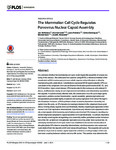The Mammalian Cell Cycle Regulates Parvovirus Nuclear Capsid Assembly
| dc.contributor.author | Gil-Ranedo, J | |
| dc.contributor.author | Hernando, E | |
| dc.contributor.author | Riolobos, L | |
| dc.contributor.author | Domínguez, C | |
| dc.contributor.author | Kann, M | |
| dc.contributor.author | Almendral, JM | |
| dc.date.accessioned | 2015-08-17T11:39:08Z | |
| dc.date.available | 2015-08-17T11:39:08Z | |
| dc.date.issued | 2015-06 | |
| dc.identifier.issn | 1553-7366 | |
| dc.identifier.issn | 1553-7374 | |
| dc.identifier.other | ARTN e1004920 | |
| dc.identifier.uri | http://hdl.handle.net/10026.1/3522 | |
| dc.description.abstract |
It is unknown whether the mammalian cell cycle could impact the assembly of viruses maturing in the nucleus. We addressed this question using MVM, a reference member of the icosahedral ssDNA nuclear parvoviruses, which requires cell proliferation to infect by mechanisms partly understood. Constitutively expressed MVM capsid subunits (VPs) accumulated in the cytoplasm of mouse and human fibroblasts synchronized at G0, G1, and G1/S transition. Upon arrest release, VPs translocated to the nucleus as cells entered S phase, at efficiencies relying on cell origin and arrest method, and immediately assembled into capsids. In synchronously infected cells, the consecutive virus life cycle steps (gene expression, proteins nuclear translocation, capsid assembly, genome replication and encapsidation) proceeded tightly coupled to cell cycle progression from G0/G1 through S into G2 phase. However, a DNA synthesis stress caused by thymidine irreversibly disrupted virus life cycle, as VPs became increasingly retained in the cytoplasm hours post-stress, forming empty capsids in mouse fibroblasts, thereby impairing encapsidation of the nuclear viral DNA replicative intermediates. Synchronously infected cells subjected to density-arrest signals while traversing early S phase also blocked VPs transport, resulting in a similar misplaced cytoplasmic capsid assembly in mouse fibroblasts. In contrast, thymidine and density arrest signals deregulating virus assembly neither perturbed nuclear translocation of the NS1 protein nor viral genome replication occurring under S/G2 cycle arrest. An underlying mechanism of cell cycle control was identified in the nuclear translocation of phosphorylated VPs trimeric assembly intermediates, which accessed a non-conserved route distinct from the importin α2/β1 and transportin pathways. The exquisite cell cycle-dependence of parvovirus nuclear capsid assembly conforms a novel paradigm of time and functional coupling between cellular and virus life cycles. This junction may determine the characteristic parvovirus tropism for proliferative and cancer cells, and its disturbance could critically contribute to persistence in host tissues. | |
| dc.format.extent | e1004920-e1004920 | |
| dc.format.medium | Electronic-eCollection | |
| dc.language | en | |
| dc.language.iso | eng | |
| dc.publisher | Public Library of Science (PLoS) | |
| dc.subject | Animals | |
| dc.subject | Capsid | |
| dc.subject | Capsid Proteins | |
| dc.subject | Cell Cycle | |
| dc.subject | Cell Line | |
| dc.subject | Cell Nucleus | |
| dc.subject | Fibroblasts | |
| dc.subject | Flow Cytometry | |
| dc.subject | Fluorescent Antibody Technique | |
| dc.subject | Host-Parasite Interactions | |
| dc.subject | Humans | |
| dc.subject | Mice | |
| dc.subject | Minute Virus of Mice | |
| dc.subject | Parvoviridae Infections | |
| dc.subject | Virus Assembly | |
| dc.title | The Mammalian Cell Cycle Regulates Parvovirus Nuclear Capsid Assembly | |
| dc.type | journal-article | |
| dc.type | Journal Article | |
| dc.type | Research Support, Non-U.S. Gov't | |
| plymouth.author-url | https://www.webofscience.com/api/gateway?GWVersion=2&SrcApp=PARTNER_APP&SrcAuth=LinksAMR&KeyUT=WOS:000357400900022&DestLinkType=FullRecord&DestApp=ALL_WOS&UsrCustomerID=11bb513d99f797142bcfeffcc58ea008 | |
| plymouth.issue | 6 | |
| plymouth.volume | 11 | |
| plymouth.publication-status | Published online | |
| plymouth.journal | PLOS Pathogens | |
| dc.identifier.doi | 10.1371/journal.ppat.1004920 | |
| plymouth.organisational-group | /Plymouth | |
| plymouth.organisational-group | /Plymouth/Faculty of Health | |
| plymouth.organisational-group | /Plymouth/Faculty of Health/Peninsula Medical School | |
| plymouth.organisational-group | /Plymouth/REF 2021 Researchers by UoA | |
| plymouth.organisational-group | /Plymouth/REF 2021 Researchers by UoA/UoA01 Clinical Medicine | |
| plymouth.organisational-group | /Plymouth/Users by role | |
| plymouth.organisational-group | /Plymouth/Users by role/Academics | |
| dc.publisher.place | United States | |
| dcterms.dateAccepted | 2015-04-28 | |
| dc.identifier.eissn | 1553-7374 | |
| dc.rights.embargoperiod | Not known | |
| rioxxterms.versionofrecord | 10.1371/journal.ppat.1004920 | |
| rioxxterms.licenseref.uri | http://www.rioxx.net/licenses/all-rights-reserved | |
| rioxxterms.licenseref.startdate | 2015-06 | |
| rioxxterms.type | Journal Article/Review |


